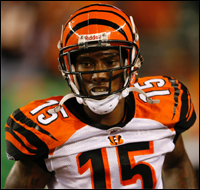Finances and Concussions
National Football League
Draft King Analysis
July 8, 2010
Lou Pickney, DraftKing.com
Reader feedback is always welcomed here. Send your thoughts to Draft King at LouPickney@gmail.com.
Yesterday I was a guest on easily the most spirited edition of The Batchelor Pad internet radio show that I've participated in to date. Unfortunately, due to the limitations of Blog Talk Radio, the portion of the show where the debate really got serious wasn't recorded. For most of it I was a listener as two other voices debated the economics of the NFL as they relate to negotiations with the NFLPA on a new Collective Bargaining Agreement.
The difficult thing about debating the issues in this situation is that much of the information needed to make an analytical decision is not available to the public. The NFL and every team but the Packers aren't likely to open their books to scrutiny, and the Packers only do so because they are required by law as a publicly-owned team. As a result, making assumptions or projections about how the negotiations might play out is a difficult, if not reckless and impossible, thing to do at this point.
As for the Packers, despite posting a 6-10 season in 2008 without Brett Favre, the team had in excess of $20 million in operating profits for that fiscal year. I haven't seen any numbers yet for 2009, but when the team in the smallest media market in the league, it tells me that the system in place is working, at least from the standpoint of long-term franchise viability.
Another topic that came up on the show is one with much more long-lasting ramifications, the reality of the danger of concussions. Results came back last month from a study of the brain of the late Chris Henry, who was a wide receiver for the Cincinnati Bengals, revealing that he was suffering from CTE: chronic traumatic encephalopathy. The only way that CTE is known to occur is via multiple blows to the head.
Not to get too technical here, but CTE is a tell-tale sign of multiple concussions, where tau proteins build up in the brain and cause damage to the neural fibers within the brain. As the above-linked article reveals, "Researchers have now discovered CTE in the brains of more than 50 deceased former athletes, including more than a dozen NFL and college players, pro wrestler Chris Benoit and NHL player Reggie Fleming."
World Wrestling Entertainment recently put a ban into place on its performers hitting one another with chair shots to the head, which is something that in the semi-controlled environment of a worked pro wrestling match can be enforced. But in football, where collisions are part of the game, protecting the brains of the players involved is much more complicated. Players already wear helmets, but there is more than just circumstantial evidence that brain damage is a legitimate risk for anyone who plays the game.
To be sure, toughness is valued in the sport. Even when an injury is something visible, players are sometimes motivated to "play hurt", particularly if they fear losing their spot in the starting lineup. Plus, what guy wants to be seen as weak or soft by his peers and coaches?
When I played football in high school, I remember an incident where a teammate of mine broke his wrist during a May intrasquad scrimmage. When he complained about the injury, the coaches ordered him to stay in, despite the fact that he was playing center. After the scrimmage he went to the ER and soon after quit the team, livid that his very real complaint was ignored. I doubt that the coaches would have kept him in there had they known the full extent of his injury, but that is the nature of the game.
If a physical, verifiable injury isn't enough to get a guy pulled from an off-season high school intrasquad scrimmage, imagine how many times a player has experienced a concussion and been ordered to get back on the field. You can't see a concussion, and with so many players moving in different directions at once on the field, it can be difficult to know if a player has suffered a brain injury on any given play.
|  |
Chris Henry, who died at age 26, suffered from CTE. (Icon SMI)
|
Of course there are ultra-violent collisions that happen where it's obvious that a prone player has clearly suffered a concussion. From Jahvid Best hitting his head in the end zone last season to Antrel Rolle being waylaid going over the middle against the Jets to Steve Young being literally knocked into retirement on a single play, big hits draw the attention of the public. But it doesn't take a big hit to cause a concussion, which creates even greater concern about the potential risk involved with football.
The NFL has been slow on the draw as far as addressing this issue goes. But, with measures in place to limit helmet-to-helmet hits and disallowing players with a diagnosed concussion to re-enter a game, at least some progress has been made to avoid multiple concussions, which is where some experts say even more severe damage can be sustained.
Just today I read this fascinating article by Alex Marvez about former NFL tight end Cam Cleeland, who suffered at least eight concussions (and probably more) during his playing days. His story is not isolated; there are scores of former players who are suffering to one degree or another from post-concussion related ailments.
There is no easy answer for this problem. Football has become the real national pastime for many people in the United States, and the popularity of the sport combined with the revenue it generates on the pro level is staggering. But at least awareness of some of the long-term risks with concussions is starting to grow across the board, and there's something to be said for that.

